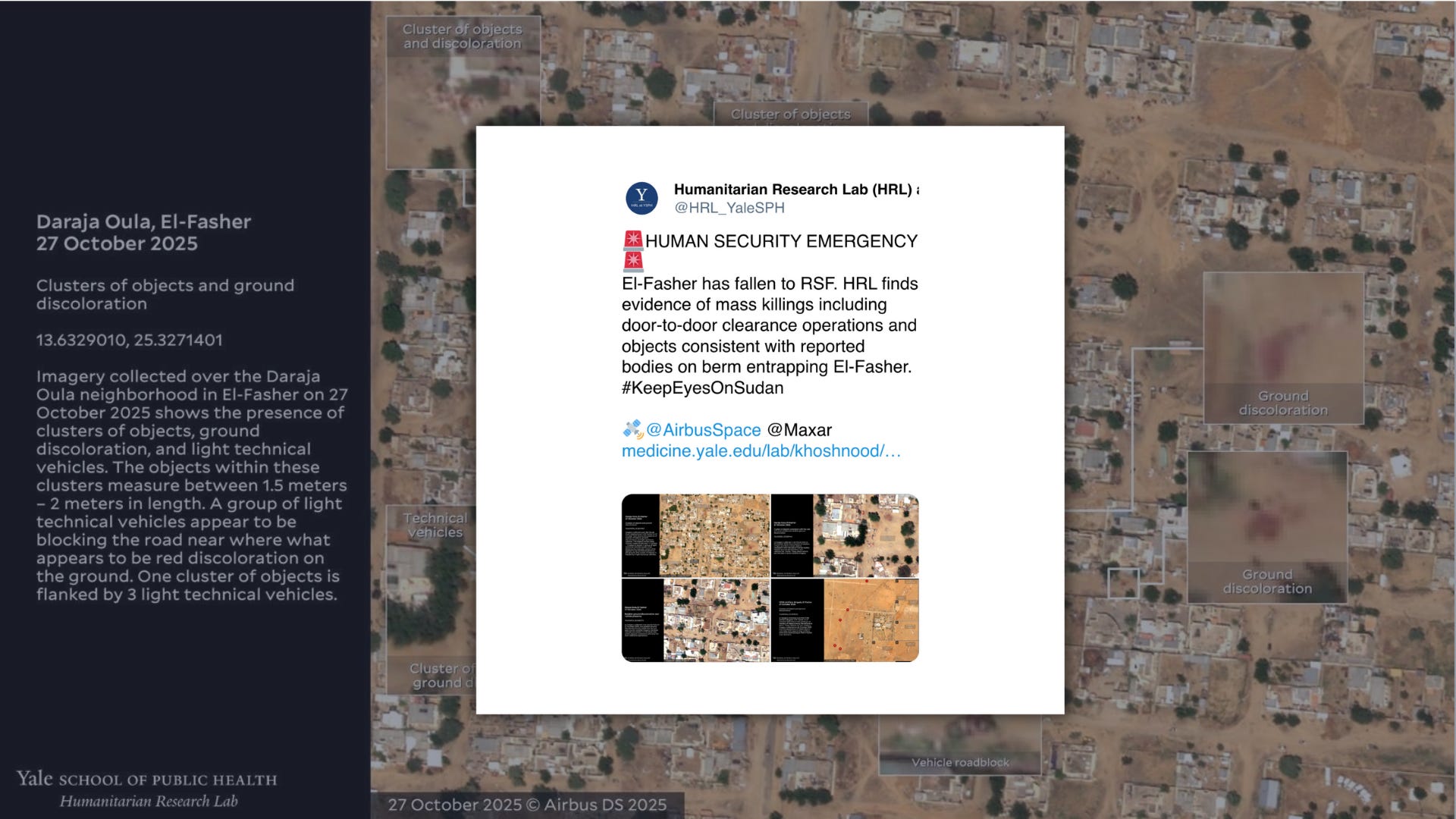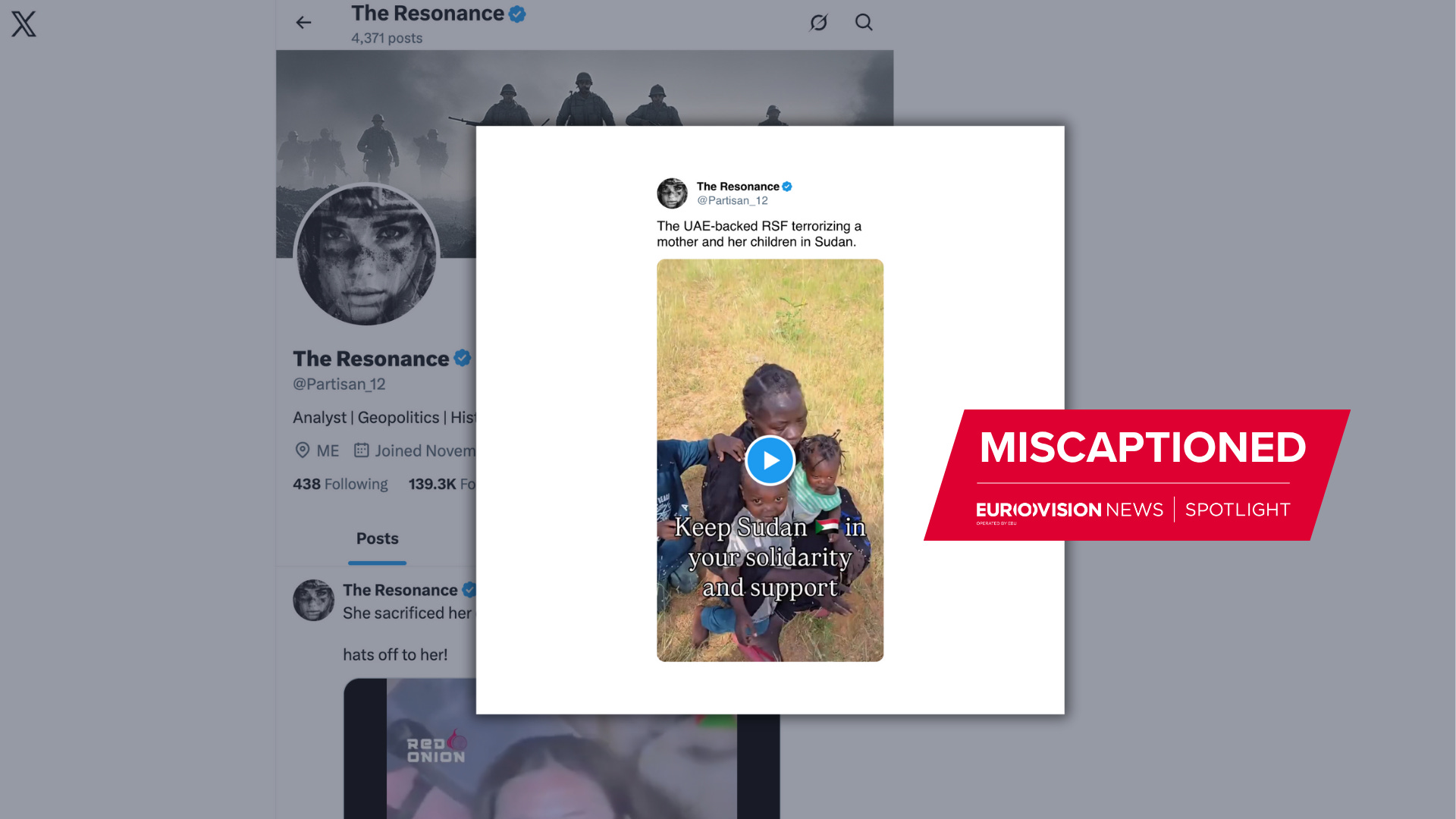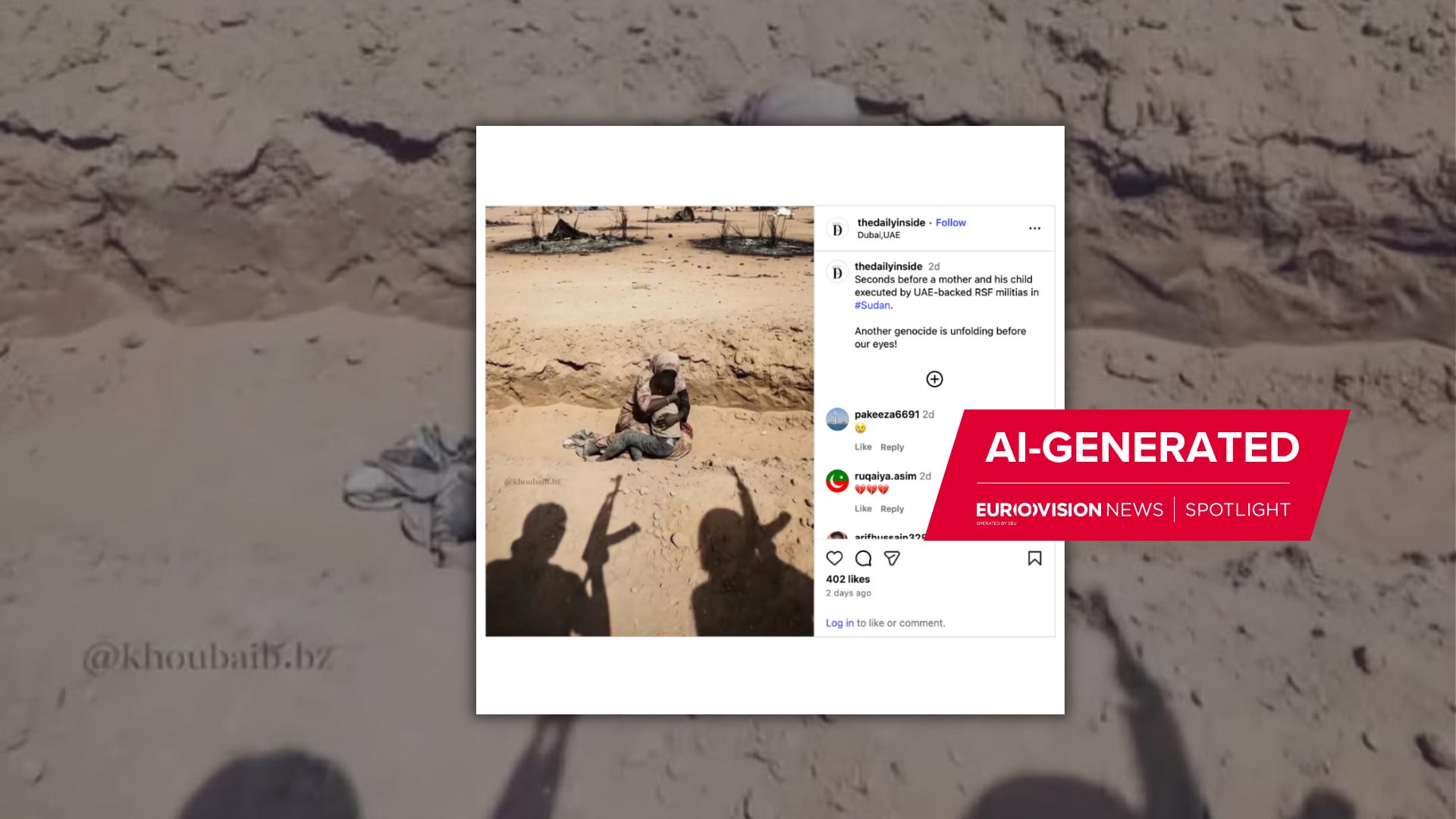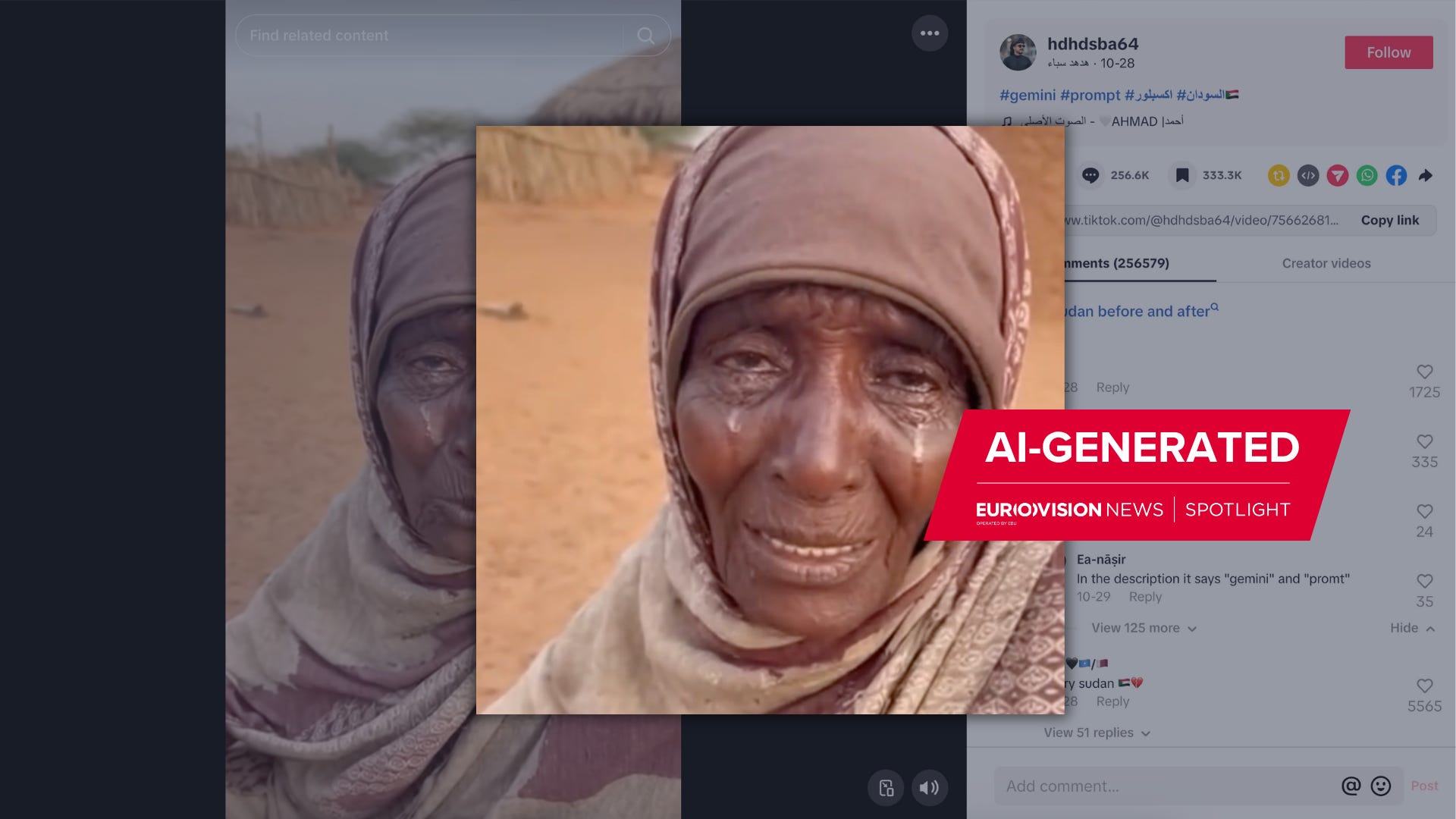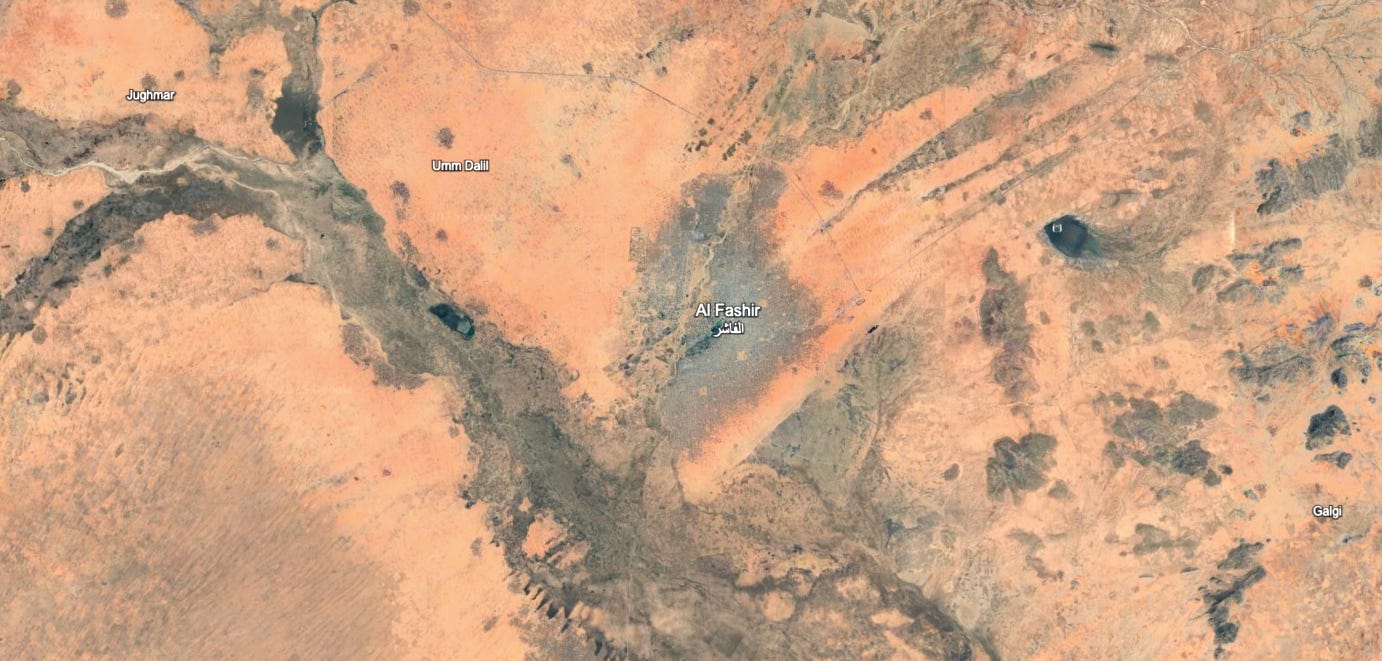Visible from Space: How satellite images and AI-generated hoaxes defined coverage of the RSF’s Capture of el-Fasher
From Yale’s satellite analysis to viral AI hoaxes, we fact-check what’s real—and what’s fake—in the Sudan conflict and the battle for el-Fasher
More than two years of war in Sudan between the paramilitary Rapid Support Forces and the country’s regular army came to a head in recent weeks when the RSF captured the key city of el-Fasher.
The move meant the army was ousted from its last stronghold in western Darfur. It also highlighted the humanitarian disaster that has long been unfolding in the country, as the RSF were accused of mass killings and other violence in areas they had taken over.
The dire situation was highlighted due to analysis of satellite images by the Humanitarian Research Lab at the Yale School of Public Health, which appeared to show clusters of objects and dark stains on the earth; dead bodies and blood, visible from Space.
Activists have consistently raised concerns about Sudan. Testimony from eyewitnesses has been patchy amid unreliable connectivity, and journalists and humanitarians have struggled to gain access to the affected territories amid widespread looting and violence.
Martin Griffiths, the UN Under-Secretary-General for Humanitarian Affairs and Emergency Relief Coordinator, said in early 2024 that it had been “very, very difficult to get attention to Sudan, which, in my view, is a place of as great a suffering as anywhere in the world today.” The crisis in the country has only deepened since then.
Another angle of this story is a renewed scrutiny of the United Arab Emirates, which has been accused of supporting the RSF in the civil war. In an announcement in early 2025, the U.S. declared that the RSF had committed genocide during the war. The UAE has refuted allegations of arming or otherwise facilitating the paramilitary group.
Precise figures on the number of people killed in the conflict are difficult to pinpoint, but a former U.S. envoy to Sudan estimated the death toll at over 400,000.
Journalists around the world, hoping to cover this story accurately and sensitively, are relying on the few pictures emerging from the affected areas. The vast gap between the demand for content and what is actually available has created the perfect environment for fake and misrepresented content to spread, purporting to show the situation in Sudan.
Misrepresented and AI-generated content
Some of the most viral content around the conflict in Sudan does not actually show what it claims, writes Matt Ford for Deutsche Welle in an analysis of various videos and images.
One video was widely circulated showing a mother and her three children, with captions saying that she was cowering in front of RSF troops who were allegedly firing weapons near her.
The footage was reshared repeatedly by large accounts. The story of the woman grew more layers when posters claimed it showed the situation as el-Fasher was captured by the RSF, and added that the mother had been killed without any evidence.
By running a reverse image search, Ford found that the video had been posted in mid-September, more than a month before el-Fasher fell to the RSF. Local language experts at DW’s Arabic desk analysed the dialogue in the footage, which suggested the men were not members of the RSF but were actually from the Sudanese Armed Forces. “They don’t appear to be threatening the woman but are rather asking her where she is from and whether she is linked to the RSF. The woman replies that she is part of the Zaghawa tribe and that the RSF arrested her husband,” Ford writes.
Other videos were also circulating. For VRT’s nws check, Ellen Debackere and Daan Nicolay investigate several clips spreading across social media, writing that, unfortunately, many gruesome images were authentic, but AI-generated material was also present.
A photo purportedly depicted a mother and child just before their execution by RSF fighters. However, there were several indications that it was actually AI-generated, Debackere and Nicolay write.
First, a small logo in the image and a reverse image search both led to the Instagram accounts of a “digital video producer” and a “creative AI specialist”. All circulating versions of the image bore his logo.
“The creator himself indicates in some places that the images were created using AI. For example, in the caption of the images on his Instagram channel, he writes in Arabic that the images were created using AI. He also includes an AI icon in an Instagram story of the image.” A video showing the same scene also had some inconsistencies, such as the merging of the woman’s arms.
Another viral image covered by VRT was also unpicked by the team at VerificaRTVE in Spain. The image depicted an elderly woman sobbing as she spoke directly to the camera. While very convincing, there are some inconsistencies around the woman’s mouth as she speaks, and she has an unnatural glow in her eyes.
RTVE fact-checkers got a high probability rating by running the video through an AI detector site. The footage could be traced back to a TikTok page run by a person who generates a lot of similar footage about news events. VRT reports that on his Facebook page, the creator even has a video showing his process for prompting ChatGPT to create materials.
Making sense of war with maps
When information is scarce, valuable insights can often be derived from open sources like satellite imagery.
That was what BBC Verify found when its team analysed the recent events for its analysis on how the RSF carried out a massacre.
After almost two years of holding el-Fasher under siege, satellite images showed that RSF troops had begun to construct a raised sand barrier around the perimeter of the city, blocking aid and sealing access routes in and out of the city, Merlyn Thomas, Matt Murphy, Peter Mwai & Richard Irvine-Brown write. “By early October the ring completely surrounded the city - with a smaller barricade encircling a neighbouring village.”
The BBC also verified several authentic videos filmed in late October, when the RSF overwhelmed el-Fasher and seized the city. “Soldiers were filmed laughing as they toured the abandoned headquarters carrying a grenade launcher. Later that day, RSF commander Abdul Rahim Dagalo - brother of RSF chief Mohammad ‘Hemedti’ Dagalo - was seen inspecting the base.”
Another graphic video analysed by the BBC Verify team showed the aftermath of a massacre at a university building in western el-Fasher, where dozens of dead bodies were seen scattered across the floor.
Meanwhile, as news spread of the Yale researchers’ findings about atrocities visible in satellite images, social media users began zooming into Sudan on Google Maps, claiming to have found more clusters and stains across the countryside. A TikTok video about the maps had nearly 10 million views just a few days after it was uploaded.
However, a closer inspection of the satellite imagery being used in Google Maps showed that it dated back to March 2024 — “Too old to show the current atrocities,” write VRT nws check’s Debackere and Nicolay.
On Google Earth, it’s possible to scroll back through older satellite captures. This confirmed that the same discolouration was there in previous years, even before the war broke out. “The figures seen in a row also resemble animals. This could be a cattle slaughterhouse, but that’s impossible to say for sure. This video certainly doesn’t show any recent atrocities by the RSF,” they write.
On November 6, there was hope for peace when the RSF said it had agreed to a truce. However, explosions were heard a day later near the army-controlled Sudanese capital Khartoum on Friday, according to AFP.



